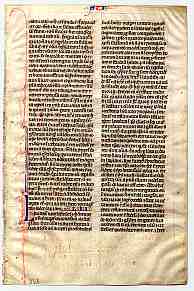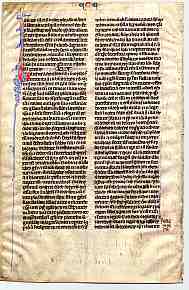

This shows the recto and verso of a leaf from a 13th century French portable Bible. These were produced in some numbers, and set certain standards for Bible production. They had running headers to indicate the names of the books, which were divided up into numbered chapters. The script is an extremely tiny simplified Gothic, derived from textura and entirely similar to that used for glosses around the edges of the main text in some Bibles and academic books. In general, the production was fairly plain with no miniatures, but tiny historiated initials were dotted in among the pages. This leaf has only fine red and blue penwork initials.
The text of this leaf is from the Book of Ecclesiasticus or The Wisdom of Jesus Son of Sirach, Chapters 43 - 45. This is part of the Old Testament Apocrypha; those books of the Bible that were excised by Jerome when he translated his Vulgate because they had no Hebrew text, so that he considered them to be not authentic. The church authorities popped them back in again just in case he was wrong about that. They are included in modern Catholic Bibles, but not Protestant ones.
The recto has a barely visible piece of Latin graffiti, written in a relatively modern hand, in the lower margin, but it is so faded that it is only possible to pick out a few words. It just shows that these old books continued to have a life of their own, long after serving their initial purpose. I have illustrated this in the text section, as well as the means for making nearly invisible old writing legible again without committing atrocities on your manuscript.
Given how long and dense this is, we will just concentrate on a segment from the verso, from the beginning of Chapter 45.
The Latin text of this section can be found at Sacred Texts, but if you look carefully you will find a number of small variations from the text as written here. The translation has come from The New English Bible: The Apocrypha 1970 Oxford University Press, Cambridge University Press
| overview | initials and headers | text | alphabet | abbreviations | exercises | transcript | translation |
If you are looking at this page without frames, there is more information about medieval writing to be found by going to the home page (framed) or the site map (no frames).